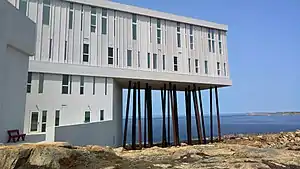Fogo Island Inn
The Fogo Island Inn is a hotel located on the northern shore of Fogo Island in Newfoundland, Canada. The inn consists of an outbuilding and main building that totals 4500m² in area. The main building includes 29 guest rooms, a restaurant, Finnish-styled roof-top saunas designed by Rintala Eggertsson Architects, a cinema run in partnership with the National Film Board of Canada, a library featuring books selected by Dr. Leslie Harris, and an art gallery curated by Fogo Island Arts. The main building has four floors, where the first and second floors house most of the public amenities, and 21 guest rooms are located on the third and fourth floors. The outbuilding includes the inn’s storage, laundry, and mechanical facilities. The Fogo Island Inn completed construction in June 2013.[1]
| Fogo Island Inn | |
|---|---|
 | |
| General information | |
| Status | Completed 2013 |
| Address | 210 Main Road Joe Batt's Arm, NL A0G 2X0 Canada |
| Town or city | Fogo Island, Newfoundland |
| Technical details | |
| Floor area | 4500m² (48,437 sq ft) |
| Design and construction | |
| Architecture firm | Saunders Architecture |
| Website | |
| https://fogoislandinn.ca/ | |
The Fogo Island Inn was designed by Todd Saunders for his client Zita Cobb. Cobb is the former CFO of a fibre-optics company[2] and founder of Shorefast, a non-profit foundation that helps to build economic and cultural resilience on Fogo Island.[3] Saunders was born in Gander, Newfoundland while Cobb was born on Fogo Island.[4] The vision of the inn was to create a space to showcase and preserve the traditional hospitality, art and culture of Fogo Island.[5] With the project being funded by Shorefast, the profits made from the inn are reinvested into the local community, helping to strengthen the once-struggling economy. Before the construction of the inn, four artist studios were constructed as a part of Shorefast’s mission to develop the island as an ecotourism destination to diversify the local economy, which is heavily dependent on cod fishing.
History
The first settlements on Fogo Island were mainly due to the abundant codfish in the area and the population was strongly tied to the cod fishing industry. However, the local economy suffered significantly up until the 1990s due to international factory overfishing in the area and the population of Fogo Island also followed this downward trend. The population drastically decreased until a declaration of a moratorium on cod fishing in 1992 to bring the population of cod back from the brink of extirpation.[6] Many of the buildings on the island have been abandoned due to the population moving elsewhere for work. This history of decline is what prompted Zita Cobb to return to Fogo Island after a successful career in the fibre-optics industry to create Shorefast.[4]
Design
The floor plan of the building resembles an “X” shape with one leg of the X running parallel to the shoreline which contains the 29 guest rooms. The other smaller leg of the X contains most of the public amenities such as the restaurant and the art gallery.[1] The placement of each guest room points its view toward Little Fogo Island just north of Fogo Island in the Labrador Sea. The site of the building was chosen to have a minimal impact on the landscape since due to the unique climate on Fogo Island, the native species would take significant time to recover if damaged.[5] The northeast section of the building consists of stilts supported made from corten steel and stands 30 feet in height which pays homage to the tradition where most local buildings are built on stilts.[1] This is an example of the vernacular architecture of the area where building a foundation into the ground was not possible due to the rocky surface. The inn is a steel-framed building but both the interior and exterior black spruce wood finishing are painted white which was intentionally designed to look like a Fogo Island saltbox house.[1]
Sustainability
Located at a remote location, the inn integrates a self-sustaining system as part of the building’s construction. Rainwater is collected from the roof, filtered and stored in cisterns in the basement while 130 solar thermal collectors are used to heat water in the building. The placement of the outbuilding helps to shield the entrance of the main building from strong winds typical on the island.[1]
Community Involvement
The construction process relied on local labour and material as much as possible. A roster of designers was brought from Europe to help create most of the interior elements of the building.[4] The designed product was then handcrafted on the Fogo Island ranging from lighting and bed covers to key fobs and wallpapers; all were made to replicate the feeling of being inside a traditional Fogo Island home. Much of the furniture created for the inn is available for purchase due to many requests from guests, which further diversifies the economy of the island.[7]
There are mixed reviews of the organization's impact on the local community, considering there is an active dispute of taxes owed to the Municipality.[8] The majority of the organization’s staff are non-Fogo Islanders. The local aspect applies to lower-paid positions while senior executive positions are held in Ontario.[9]
References
- Carroll, Michael. "X Marks the Spot". Canadian Architect. V.58 N.11: 47–42.
- McKeough, Tim (2010-12-15). "How Multimillionaire Zita Cobb Plans to Turn a Tiny Canadian Island Into an Arts Mecca". Fast Company. Retrieved 2022-07-08.
- "Our activities". Shorefast Foundation. Retrieved 2022-04-13.
- "TVO | Current affairs, documentaries and education". www.tvo.org. Retrieved 2022-04-13.
- Carroll, Michael. "The Fogo Island Experiment" (PDF).
- "Cod & The Fisheries". Fogo Island Inn. Retrieved 2022-04-13.
- "About Us". Fogo Island Workshops. Retrieved 2022-04-13.
- "CBC Shorefast Requires Mediation to Pay Taxes".
- "Open Corporates".